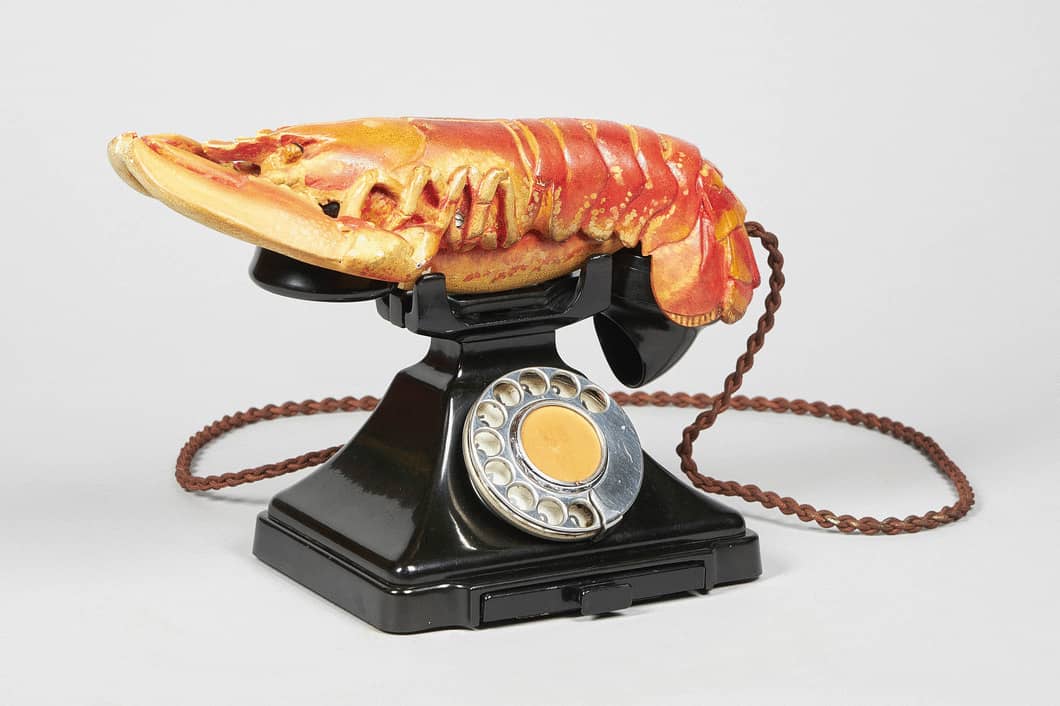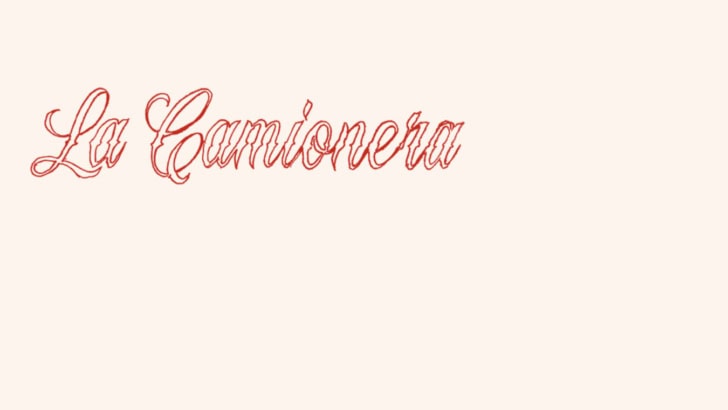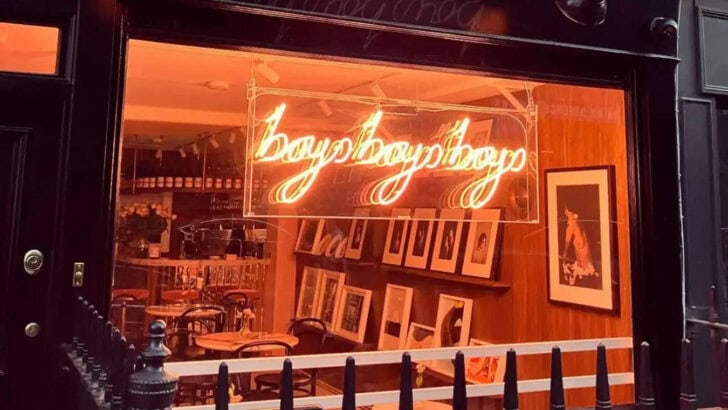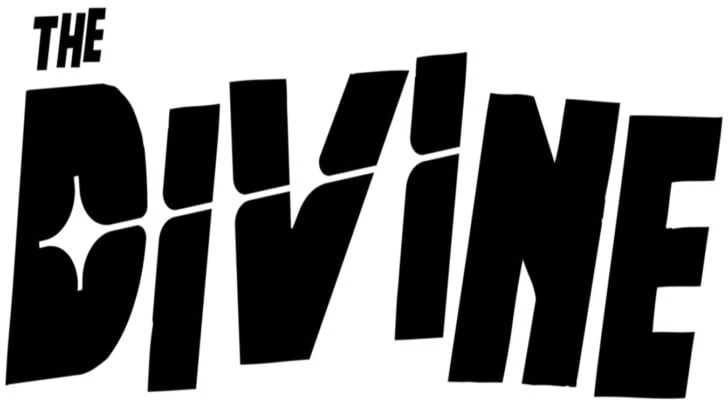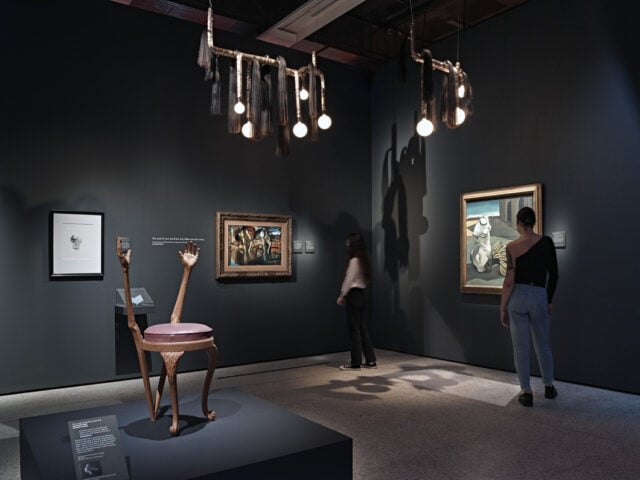
The Design Museum explores the relationship between fine art and design in a new major exhibition. In Objects of Desire: Surrealism and Design 1924 – Today, the museum surveys the Surrealism movement and examines how it revolutionised art and design: from decorative arts and furniture to interiors, photography, film and fashion. With nearly 350 objects on display, the collection includes works from several iconic queer artists and designers. Artworks and objects from Man Ray, Marcel Duchamp, Salvador Dalí and Leonora Carrington are alongside pieces by Sarah Lucas, Tim Walker, Björk, and Dior.
The exhibition covers nearly 100 years and contains significant Surrealist paintings and sculptures – such as Man Ray’s The Gift (Le Cadeau) and Dalí’s Lobster Telephone. Nearly a third of the objects are from the past 50 years. They are on show alongside dozens of contemporary art and design pieces. Lenders include the Vitra Design Museum in Germany, private collections and leading institutions, including the Tate and the Sainsbury Centre for Visual Arts.
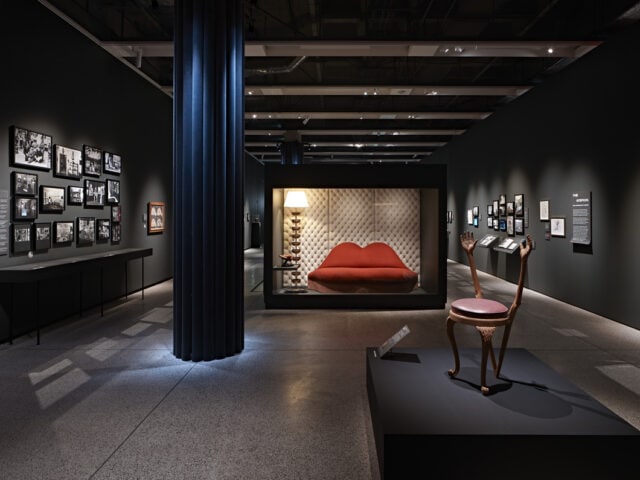
Split into four sections, the exhibition focuses on Surrealism’s influence on everyday objects, interior design, fashion and the body, and the mind. It examines Surrealism’s beginnings in the 1920s and considers the crucial role that design played in its evolution. The movement’s early protagonists embraced everyday objects and interiors, as artists sought to capture ordinary household objects’ aura or mysterious side. Artists including Magritte, Dalí, Meret Oppenheim and Man Ray experimented with a new form of sculpture by creating absurd things from everyday materials and items they found. Famous examples of these early surrealist sculptures include Man Ray’s Cadeau/Audace(1921), comprising of a traditional flat iron studded with nails and Magritte’s sculpture and painting This is a Piece of Cheese (Ceci est un morceau de fromage) (1936 or 1937). Marcel Duchamp’s Porte-Bouteilles (1959 re-edition of lost 1914 original) is called a ‘readymade’ artwork as it was made from a bottle rack and is considered one of the most influential sculptures of the 20th century.
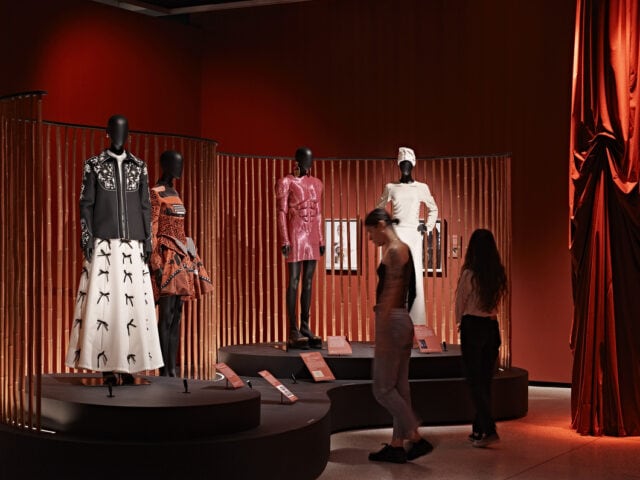
In the 1940s, inspiration began to move in the opposite direction. Designers looked to Surrealist art for ideas to create surprising, sometimes humorous objects. The humble bicycle became a common motif. Gae Aulenti’s Tour (1993) is a table made from a glass top supported by four bicycle wheels set in chrome forks alongside Jasper Morrison’s own ‘readymade’ Handlebar Table (1982). Sella (1957), by the brothers Achille and Pier Giacomo Castiglioni, is a work made up of a bicycle saddle mounted on a post fixed to a hemispherical base, thus blurring the boundary between furniture and art.
This modern art and design movement focused intensively on the body, sexuality and desire. The section relating to Surrealism and the body examines the movement’s embrace of the human form as a canvas. The exhibition shows photographs of Marcel Duchamp dressed as his female alter ego, Rrose Selavy. At the same time, Claude Cahun’s Self-Portrait (in the Mirror) 1928 is a striking expression of her style and composition that blurs conventional gender indicators. Contemporary works, including Sarah Lucas’ Cigarette Tits, use the language of the tabloids to expose stereotypes of female sexuality, and Najla el Zein’s Hay, from her series, ‘Sensorial Brushes’, draws attention to the sensory pleasures offered by everyday materials.
The exhibition also highlights Surrealism’s specific significance in the UK. Including the partnership between Salvador Dalí and Edward James, a British poet and art patron, whose friendships and collaboration resulted in world-famous Surrealist interior design pieces. These included the Mae West Lips sofas, the most significant piece of Surrealist furniture in the UK. At the suggestion of James, five versions were created in 1938 by Dalí. Alongside is a pair of Champagne Lamps. These take the form of a Victorian standard lamp with a base made from whimsically oversized ‘champagne glasses’ in brass and are re-united with one (of the four originals) Lobster Telephone works by Dalí, which were all commissioned by Edward James for his London residence.
Surrealism’s influence on fashion began in the 1930s. Some Surrealist artists also worked as fashion photographers. They include Lee Miller and Man Ray, and some, such as Dalí and de Chirico, created covers for fashion magazines such as Vogue. Photographs and vintage copies of these magazines are on show to highlight these connections. They are seen together with Surrealism-inspired photography for modern-day magazines, including Tim Walker’s photo shoot with actress Tilda Swinton for W Magazine in 2013.
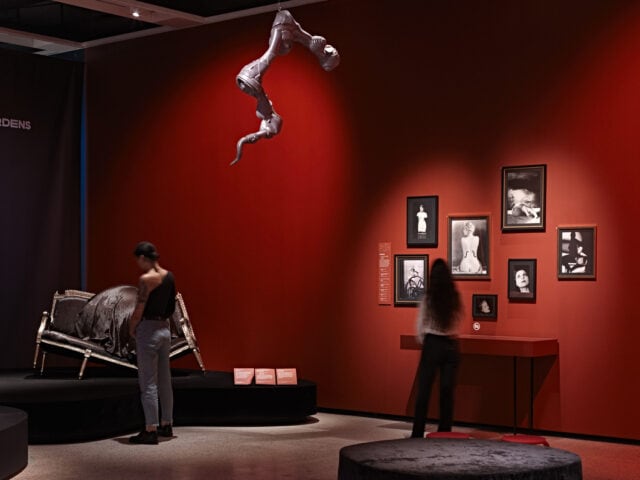
Dalí’s collaboration with the French fashion designer Elsa Schiaparelli resulted in ground-breaking designs. The Telephone Dial Powder Compact is a highlight of the exhibition – this must-have 1930s accessory was their first collaborative piece and was so successful that it was widely faked. The collection also highlights Surrealism’s enduring influence on Maison Schiaparelli, the haute couture house created by Schiaparelli in 1927. Two stunning contemporary gowns are in the exhibition: one uses Maison Schiaparelli’s signature pink on a shocking minidress with a muscular shape, and the other is a modern replay of her iconic Skeleton Dress. Both demonstrate Maison Schiaparelli’s creative director Daniel Roseberry’s contemporary take on Elsa Schiaparelli’s design language. Also on show is Maria Grazia Chuiri’s ‘Salvador Dalí’ ensemble. The pieces were inspired by Dalí’s historical collaboration with Christian Dior on costumes for ‘The Ball of the Century’ in Venice. Iris van Herpen, Mary Katrantzou and emerging Afro-surrealist-inspired fashion designer Yasmina Atta have also loaned garments to the exhibition.
“The exhibition is both a landmark in the history of Surrealism and design and part of a rich and ongoing story of London’s engagement with one of the great cultural movements of the last century.” – design museum
Surrealists worked with the everyday objects around them. Today, those everyday objects include powerful technology systems that govern our lives in ways never previously thought possible. The exhibition examines how contemporary artists and designers embrace these rapid changes to shake up the creative process, discover new tools, and think differently. For example, contemporary designers Ronan and Erwan Bouroullec’s sketches on display use an intuitive, automatic drawing process to find new imagery and forms. This represents a 21st-century continuation of the strategies by which the early Surrealists hoped to invite chance into the creative process, allow the subconscious to find expression, and free themselves from conventional art and design practice.
Also on show are examples of Sketch furniture, which is traced by the designer’s hand and body in mid-air using motion capture. The spontaneously drawn forms are translated into a digital file and then 3D printed to create functional furniture. Design studio Front innovated this method in 2005 to introduce instinct and physicality into the design process. It is one of the most striking examples of how technology offers exciting new avenues for Surrealist ideas.
“The early Surrealists were survivors of the First World War and the 1918 influenza pandemic, and their art was partly a reaction to those horrors. Today, in the context of dizzying technological change, war and another global pandemic, Surrealism’s spirit feels more alive than ever in contemporary design.” – design museum
Tickets are on sale at designmuseum.org/surrealism
Objects of Desire: Surrealism and Design 1924 – Today. Open now at The Design Museum and runs until 19th February, 2023.
